I would give our relationship with the UK – and now, especially after these two days with your Prime Minister, I would say the highest level of special. Am I allowed to go higher than that? I’m not sure.
Donald J. Trump, 45th President of the United States, following his state visit to the UK, June 2019
It’s always nice to look at the inspiring and eloquent words of our political leaders to add a sense of reality to the often abstract talk of football analysis. Whilst President Trump gushed about the Queen, Brexit, Boris Johnson and whatever filled his Twitter feed during his two-day visit to the UK last month, his presence was an important barometer when understanding how close the Old World and the New World had become. There is no doubt, however, that tonight’s game in Lyon could test Trump’s own definition of the word “special”.
In this tactical analysis we shall see how England have the potential to cut out the US’ attacks before they’ve even begun, how Megan Rapinoe’s positioning on the left is a deliberate and difficult proposition to defend against, how Lucy Bronze must deal with this threat but still lead England’s attack from the right flank, and how Jill Ellis has a defensive mechanism so well drilled, it could reinvent defensive play.
Tactical analysis: lineups and shape
For all his prior talk of having contrasting styles and different tactical muses, critics were perhaps correct to suggest that this was all bluster Neville was employing as he faked-until-he-made it. With their recent performances, as well as the increased difficulty of the opposition, we’d expect him to retain his developing 4-2-3-1 formation. Likewise, in terms of playing personnel, Neville will look for consistency.
The major change Neville made for their previous game was the replacement of Alex Greenwood at left back for Demi Stokes. The Mancunian rivalry has extended to the left back spot and given her previous performance, Neville would be wise to stick with Stokes. Despite winning only one of her six defensive duels against Norway, which measured up to a success percentage of 17%, Greenwood’s tournament has been less than water-tight. Even though her average success rate accrued some hyperinflation from England’s pummelling of Argentina, it comes out largely similar to Stokes’.
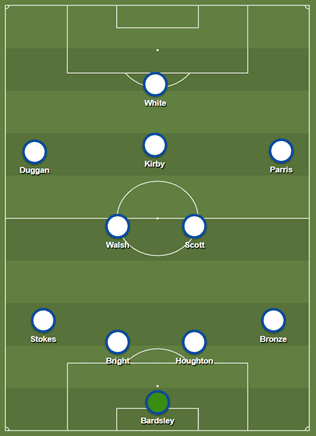
On the other side of the park, things seem a lot safer to predict. The USA have powered through the tournament and into this semi-final with their iconic 4-3-3. The shape provides both attacking as well as defensive flexibility. As the USA’s hegemony over world football has been slowly chipped away with each passing game, the side cannot allow arrogance in either department to get the better of them.
The USA’s only personnel changes have been the rearranging the vertebrae in their defensive spine. When Julie Ertz sat in the back line whilst Becky Sauerbrunn overcame an injury against Thailand, we saw Lindsey Horan drop into the middle of the field. Since Ertz’s ball playing qualities match her undeniable defensive skill and she’s played as a defensive midfielder. We expect the USWNT to main this squad for their upcoming game. Indeed, Ertz’s passing percentage of 77.25% during the World Cup trumps her season average of 75.7%. This did take a hit against France, where a strangling high press kicked this down to just 59%, and this is somewhere England should target.

England adopting a high press
One defensive innovation which Neville’s side must incorporate in their game against the United States will be a high press. This is something which England, in fairness, have a prior track record of. According to wyscout.com, England average a PPDA (passes allowed per defensive action) of just 8.74. For context, if we are to apply this to that which Manchester City’s men’s team generate, the high-pressing demons reared on Pep Guardiola’s cocktail of his opponent’s blood and nervous tension, we can see some remarkable closeness.
City led the English Premier League PPDA table with 8.46. Their next closest rivals, Everton, have a comparatively relaxed 9.36. It’s not just enough to say that England will definitely bring football home because they defend in a high-octane way, however. Yet, this style of play could be uncomfortable enough for the USA that it could put the tie on a knife edge.
In the below graphics, we can see Nikita Parris chasing a wayward long ball. She is applying pressure on Kristine Minde and driving her out wide to the touchline:
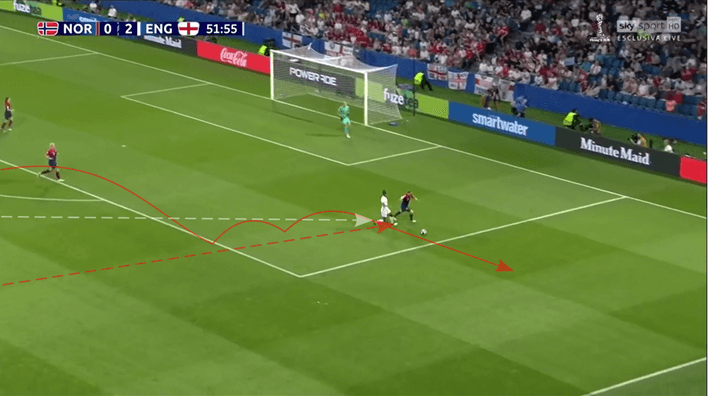
Minde’s pass inside immediately draws Lucy Bronze to press the receiver. The significance of this press is that Bronze is angling her opponent inside, opening her body up. Parris has Minde and the wing area covered for any potential one-two, whilst three England players have all positioned themselves to press the next available pass, in the middle of this small area.
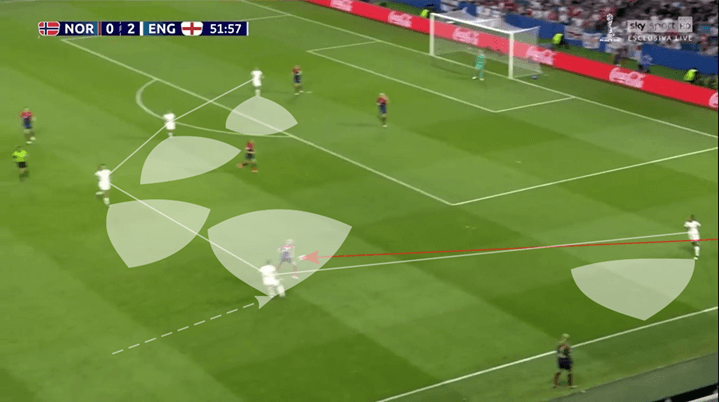
Although Bronze’s challenge is deemed a foul from behind, we can see that England’s corner press had the potential to immediately put Norway under pressure. The tackle from Bronze could easily put Parris through in a gaping half-space, who is well onside. Jill Scott is positioned to also drive into this space, or support Bronze and Parris from behind. Likewise, Ellen White is located high, and Fran Kirby has acres of space in the middle. This could be used to engage a late run or pull back, should Parris get on the ball.

In the USA’s battle versus Spain, Sam Leveridge was adamant that a sustained, high defensive effort could have brought greater rewards for La Roja. Spain averaged a 10.68 PPDA against the USA, and against the French, this was almost cut in half to 5.76. Considering the scorelines were tight at just 2-1, the Lionesses will need to avoid the generous 168 which Thailand allowed in their 13-0 defeat.
#mypresident
England could press to excess, however. Without a doubt, the most concerning challenge the USA harbour is their ambidextrous wing-play. The champion of this, the one player who goes into this game making both world leaders and English coaching staff tremble, is Megan Rapinoe. With five goals in the tournament so far, including two braces in two games, she is the player England must be wary of.
Intelligent, two-footed, spatially aware and astute in her decision-making, few can doubt that Neville’s backroom staff will have had tabs on the American going into the game. At the same time, as we shall see in this tactical analysis, stopping her from getting on the ball will be a challenge.
As the United States attack in their 4-3-3, with the USWNT generally preferring the right side to initiate these manoeuvres, Rapinoe stays out wide on the left, blindsiding any potential markers. Crosses are a danger for England, as the USA have averaged 18.38 per game this calendar year, with well over a third of these meeting their target. This is in decline but England must be wary.
In the below, we can see how Alex Morgan has dropped incredibly deep and wide on the right. This allows for the inverted, underlapping run of Tobin Heath. Morgan drives insides and finds Heath. Meanwhile, in a wide channel shared with the defender Crystal Dunn, Rapinoe lurks menacingly wide of Marion Torrent’s left shoulder. Out of Torrent’s field of vision, the winger can both assess the movements of the ball and avoid the suspicions of the defender. She is also far enough away from the French right-winger, to avoid being tracked.
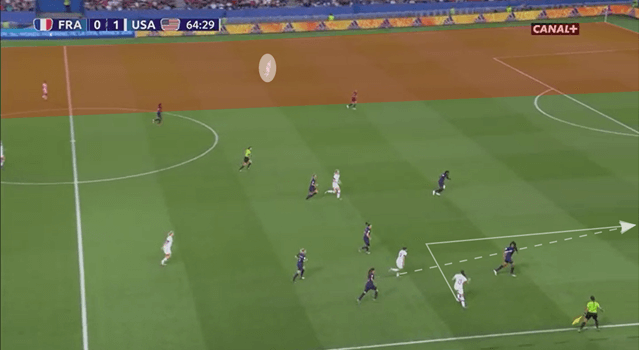
As Heath pull the ball back and Torrent sprints to put off the free American striker, Rapinoe still has plenty of time to judge the path of the ball. Notably, the ball bobbled horribly, meaning that both attacker and defender missed the ball. Rapinoe has delayed her run perfectly, sneaking into the box unannounced.
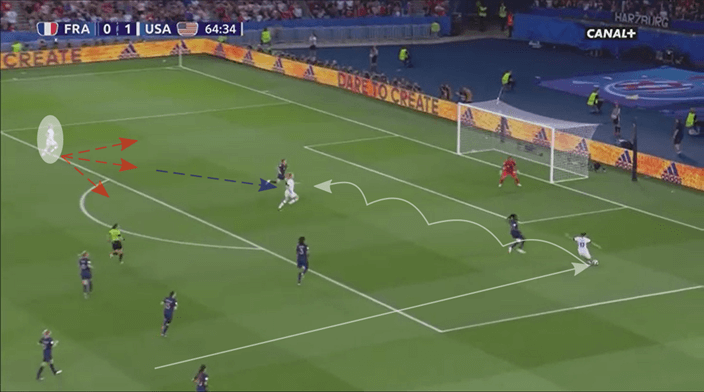
As Rapinoe finally goes to meet the ball, Torrent is aware of her error but is unable to recover. Rapinoe fires in brilliantly to secure passage to the semi-final.
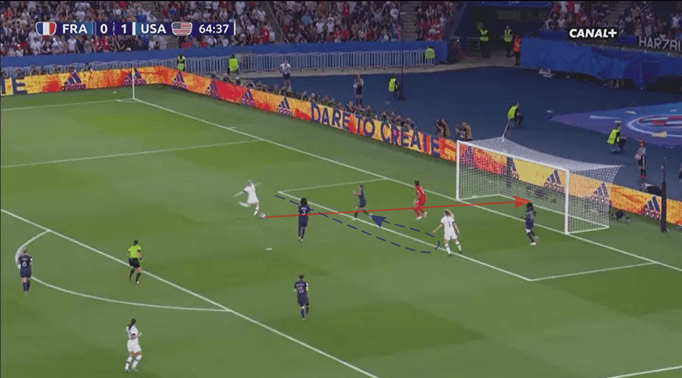
With the threat that she is always behind you, England will need to deal with this creatively. Will this mean letting Bronze drift into the middle but with Parris dropping deeper to mark her? It could be one way England try to nullify her.
Coming outta my cage, and I’ve been doing just fine
This is not to say that Rapinoe’s very touchline will be the side where just England may get hammered, however. Despite her obvious defensive prowess, The Lionesses have relied on their “Miss. Rightside”, Lucy Bronze, in attack just as much. Against Norway, Bronze was absolutely phenomenal and her defensive and attacking contribution was such that she rightfully won the man of the match award.
When squared up against Rapinoe, Bronze will again need to justify her reputation as the world’s best right back. We’ve already said that this won’t be easy, and this will be because she will have to balance the attacking-defensive knee-jerks which will naturally spring up in game.
Defensively speaking, we know how England will need to keep Rapinoe occupied to prevent her threatening with her famed late runs. But it’s in attack where Bronze really made her mark against Norway, and with her flourishing working relationship down the right-side with Parris, this will be England’s best chance of catching the Americans out.
So what do we know about how Bronze is going to attack? Statistically speaking, England’s crossing game has been in decline as the standard of opposition has improved. One thing that has remained a constant, however, is Bronze’s determination to dribble into the opponents’ half and play defence-splitting passes. The below table shows how these statistics have altered with each passing game:

Against Norway, we saw Bronze consistently pushing high into her opponents’ half. This then allowed Parris to pull wider or dart into the half spaces between the defenders. Another notable beneficiary of Bronze’s wing dynamism was Ellen White. The below series of graphics show an iconic line-splitting run from deep in her own half:
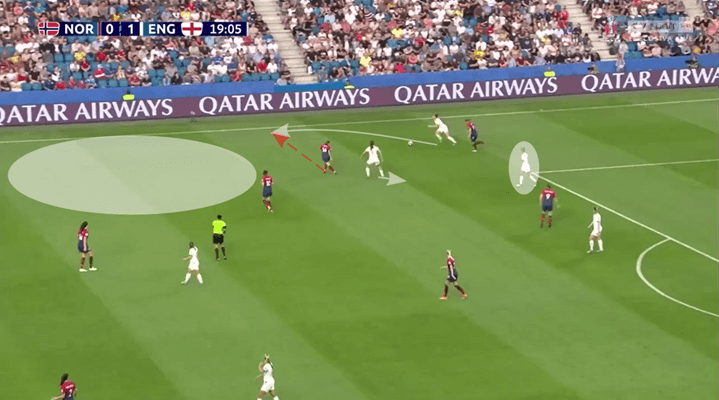
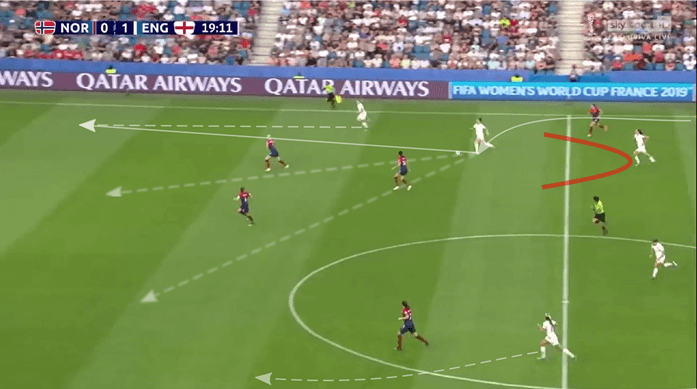
But what is also remarkable is how her teammates support and enable her. In the first still, Parris has dropped into the right-back position, anticipating Bronze’s run. As she transitions upfield, we see how Scott has continued to run but almost as a withdrawn blocker from American football. In this position, Scott is able to cover the space immediately in Bronze’s wake, preventing pressure on her.
Likewise, Toni Duggan angles her run leftwards and White has moved to the right side. The fainter, jet stream-like arrows show potential runs Bronze could make. In this instance, she did not continue her run with the same pace, and slowed to a halt, however. Regardless, Bronze is not a defender who makes audacious and rogue runs from the back – this is a tactic England rely on.
USA’s organised retreat
The United States are wily competitors, however. The dominance the USA have held over the game and the prevalence of their own domestic leagues have led to the speciation of tactics. In the case of playing defensively, Ellis has instituted a defensive ideal which is both hard to define as well as potentially groundbreaking. We’ve termed this the “organised retreat”. It is rather comparable to the total football of the Rinus Michels of Ajax, Barcelona and Holland, and Valeriy Lobanovskyi of Dynamo Kiev and the Soviet Union.
The major difference is that the interchanging of positions occurs primarily when defending. Whilst the USA are winning the ball back in increasingly deeper areas, they are managing to remain composed to do so. Against Spain, a game in which the USA faced an unexpected test, they won the ball back 40 times in their own third, and 34 times in the middle third, and 19 times in Spain’s. The below image shows the 36 recoveries which they made from good defensive positioning:
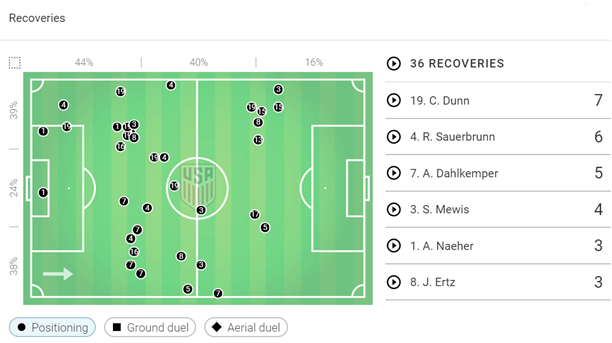
Unsurprisingly, three of the USA’s four defenders won the highest number of positional recoveries. What is slightly more interesting is where the ball has been won, however. As mentioned, most have been in their own half but with a considerable proportion further forwards also. Similarly, they have often been in inside areas. This suggests that the USA are packing their defence and midfield tightly. Furthermore, it shows that they are directing their opponents into these areas to trap them.
In the below graphics, we can see how the USA transitioned quickly into a defensive shape from conceding the ball from their own corner. In the first image, we can see how Dunn moves towards the ball player, whilst a central midfielder drops into her position to cover. The USA are desperate to transition back to a 4-3-3 defensive shape, as the blue lines indicate. The wide players on their right side are out of shot.
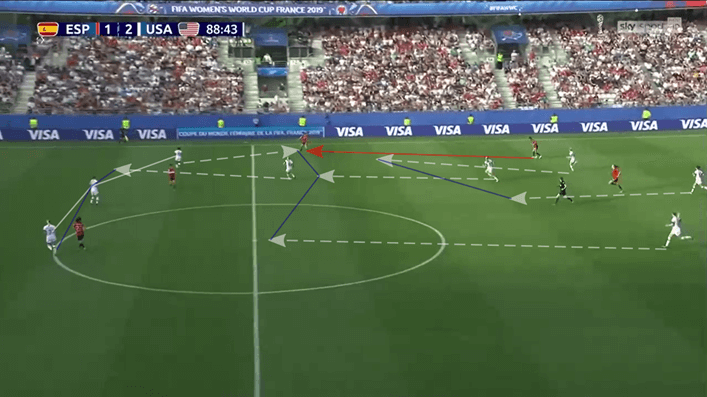
After Spain are pushed back and do well to open up space in the middle of the pitch, we see the USA’s defensive metronome spring into action. Rapinoe drops into the midfield line as the nearest midfielder tries to press the cushioning player. Likewise, Heath also drops to try and sure-up this defensive wall. The USA are layering their defence but simultaneously inviting Spain to attack them gradually. They are consciously moving two players back for each one advancing. This teases the Spanish back slightly, affording the Americans time to revert to a more solid defensive shape.
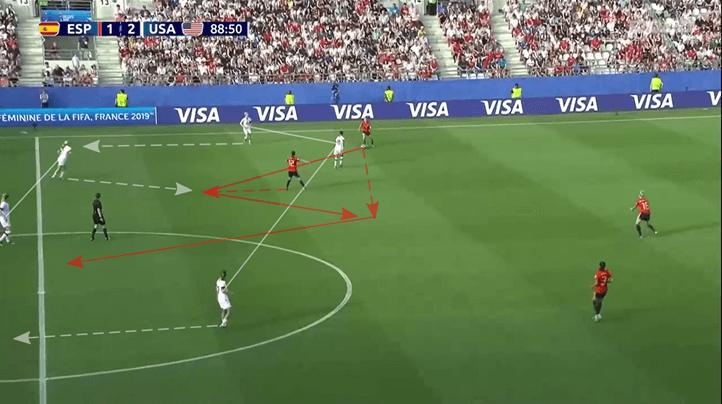
With now five players in the back line, the USA decide to drop further. The two American midfielders highlighted with blue arrows drop in to cover spaces. Once again, a central player presses the ball carrier ever so slightly, and this pressures her to move the ball out wide. From this position, the USA can strangle the attack when the ball moves back inside due to their superior numbers.
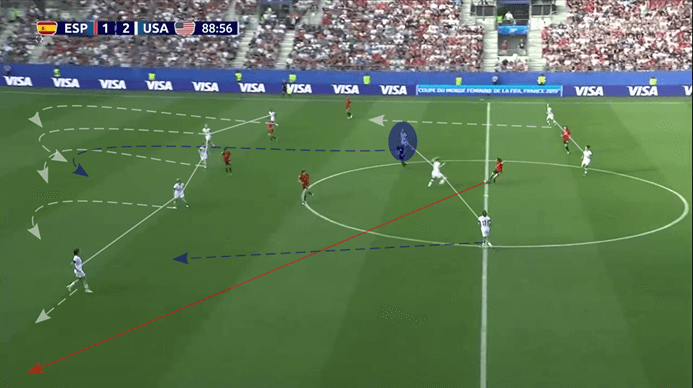
Conclusion
This game has the foundations to be an absolute classic, worthy of complete Donald Trump-level hyperbole. Whilst England have been a slow-burner heading into the tournament, arguably the United States have realised how close the rest of the world has become to challenging their dominance. Regardless, both coaches must feel that they can progress to the final. Each side is well drilled and drenched with talent. Tactically speaking, each have their own nuances which the other must address. Failure to do so will surely be exposed by two strategically astute teams.
England must press their opponents with consistency and ferocity to win the ball back, as the USA’s best recent challengers have all done. Whilst doing this and pushing Bronze into attacking positions, they must also be wary of American counterattacks. Rapinoe will be crucial for the USA’s firepower but her idiosyncratic movement will not be easy to handle. Finally, England’s attacking flair could be all in vain. Ellis’ defensive ingenuity is something truly revolutionary. Indeed, either team that wins this contest would be justly favourites to be world champions.
If you love tactical analysis, then you’ll love the digital magazines from totalfootballanalysis.com – a guaranteed 100+ pages of pure tactical analysis covering topics from the Premier League, Serie A, La Liga, Bundesliga and many, many more. Buy your copy of the June issue for just ₤4.99 here, or even better sign up for a ₤50 annual membership (12 monthly issues plus the annual review) right here.

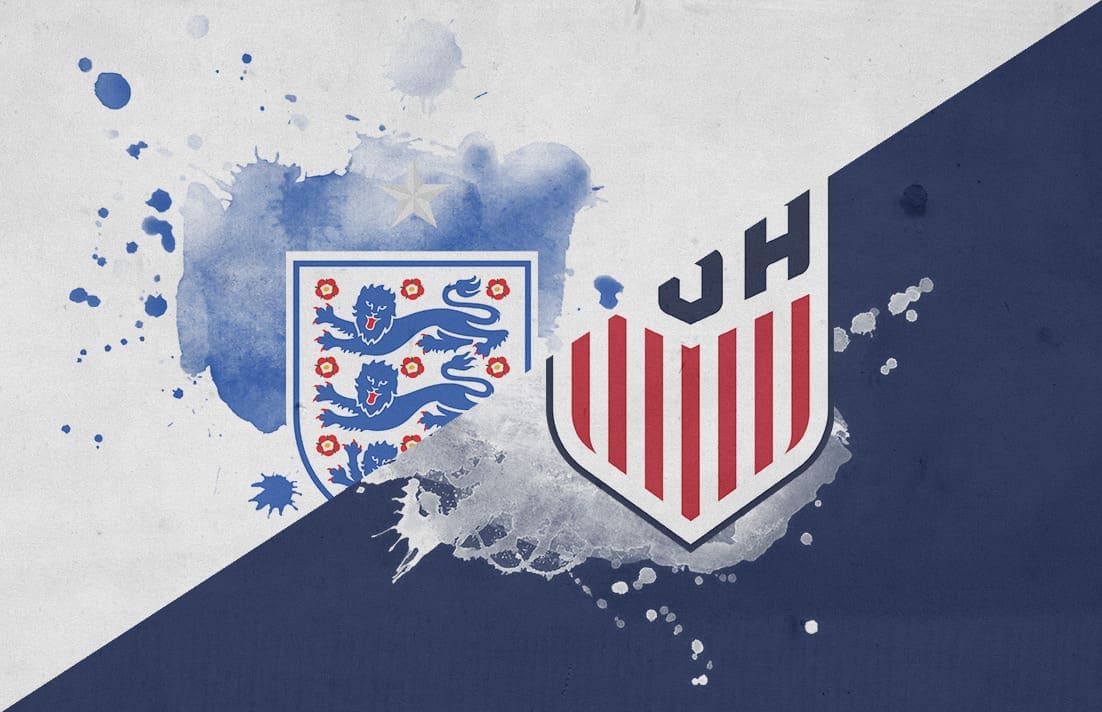



Comments